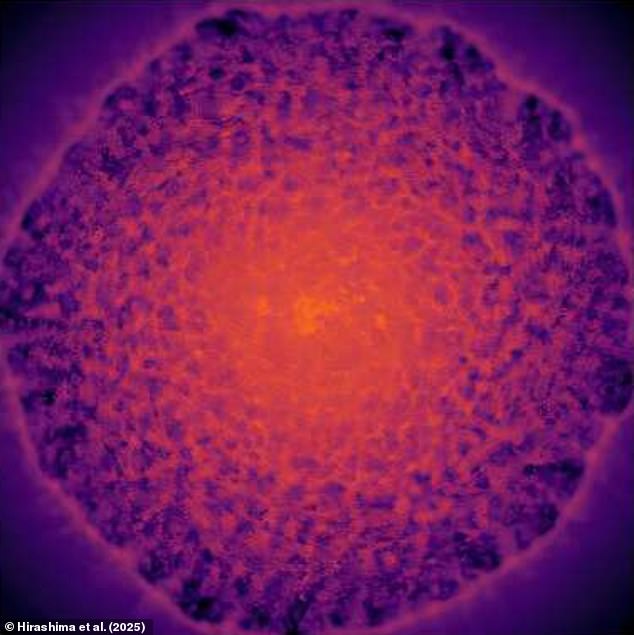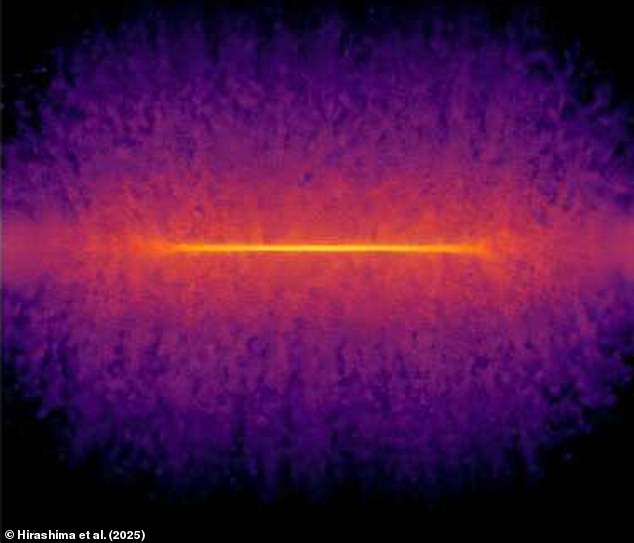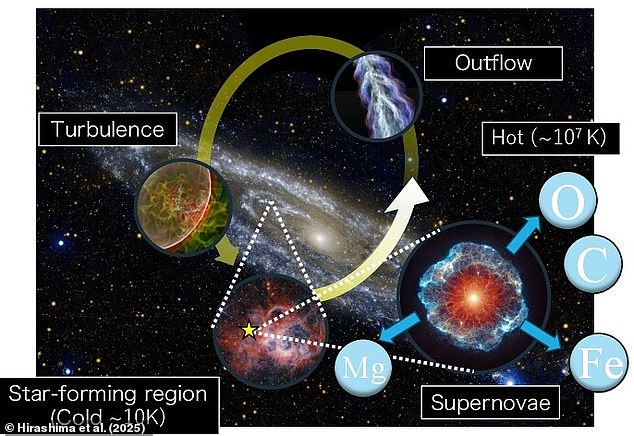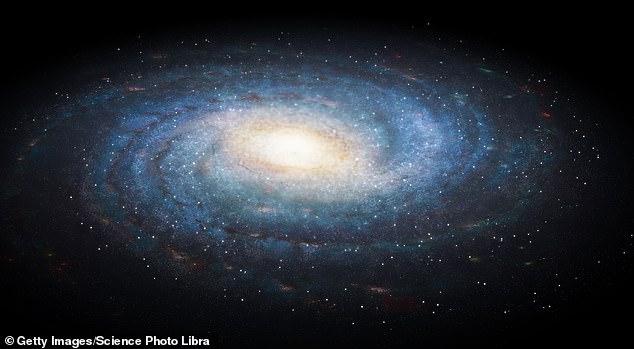Scientists from Japan‘s RIKEN research centre have created the most detailed simulation of the Milky Way ever made.
The incredible galactic map charts more than 100 billion individual stars over the course of 10,000 years.
Researchers use simulations like these to test theories about how the galaxy formed and changed over time.
However, this is the very first ‘star-by-star’ simulation of our home galaxy to chart the evolution of the cosmos with such stunning detail.
Even the best cutting-edge computer models struggle to accurately simulate complex movements of 100 billion stars in the Milky Way.
This is because the galaxy is shaped by forces on both the enormously large and extremely small scales of distance and time.
Galaxy simulations must consider gravity, fluid dynamics, supernova explosions, and the creation of elements in the hearts of dying stars.
Now, by using AI, the researchers say they can make simulations that track 100 times as many stars.

Scientists have created the most detailed simulation of the Milky Way ever created, charting the movements of 100 billion stars over 10,000 years. Pictured: A top-down view of the simulation showing areas of gases in red

Most simulations struggle to render more than a billion stars at a time, forcing them to group hundreds of suns. However, this is the very first true star-by-star simulation, plotting the movement of every individual star. Pictured: A side-on view of the simulation
Because changes in the galaxy take place over such a long time, scientists can’t just sit back and watch to learn about galactic evolution.
By looking at galaxies that are very far away from Earth, astronomers can get an idea of what galaxies might have looked like at an earlier point in the universe’s history.
However, this data only provides a snapshot and doesn’t tell us anything about our own galaxy.
For that, astronomers are now trying to create powerful computer simulations that work out how stars would move and evolve based on what we know about the laws of physics.
By changing the rules of the simulation and comparing the results to the universe around us, scientists can learn more about how our galaxy came to be.
The problem is that the Milky Way is enormously vast and incredibly complex, making it far too difficult for any normal computer to simulate.
In the past, scientists had tried to build bigger and more powerful supercomputers to run more complex simulations.
However, if the best conventional simulation to date tried to model the Milky Way down to the individual star, it would take 315 hours for every million years of simulated time.

Simulations of the galaxy are used to test our theories about how stars and supernovae form over time. But these processes are so complex (illustrated) that most simulations would take 315 years to model a billion years of history
At this rate, simulating just one billion years of the Milky Way’s 13.61-billion-year history would take more than 36 years.
To solve this problem, lead researcher Dr Hirashima, of the RIKEN Center for Interdisciplinary Theoretical and Mathematical Sciences (iTHEMS), alongside colleagues from the University of Tokyo and Universitat de Barcelona in Spain, tried a new approach.
Instead of simulating the physics of every single process, the researchers let an AI fill in some of the gaps.
The ‘surrogate’ AI was trained on thousands of highly detailed simulations of supernova explosions and learned to predict how the gases would expand over the next 100,000 years.
By allowing the AI to do much of the heavy lifting, the researchers were able to make their simulation 100 times larger and complete it 100 times faster.
When they compared their results to simulations painstakingly created on some of the world’s largest supercomputers, the researchers found that they matched.
The researchers charted the movements of 100 billion stars over one million years in just two hours and 47 minutes.
This means that one billion years of the galaxy’s history could be simulated in a mere 115 days, not 36 years.

By using AI, the researchers’ new model could simulate the movements of 100 billion stars over a billion years in just 115 days. This makes it 100 times more detailed and 100 times faster (stock image)
Dr Hirashima says this new method could mark a ‘fundamental shift’ in how scientists simulate the galaxy.
He says: ‘This achievement also shows that AI-accelerated simulations can move beyond pattern recognition to become a genuine tool for scientific discovery – helping us trace how the elements that formed life itself emerged within our galaxy.’
In the future, these same techniques could be used to improve other areas where highly detailed simulations are used.
That could lead to a better understanding of ocean currents, more accurate models of climate change, and even better weather forecasts.

